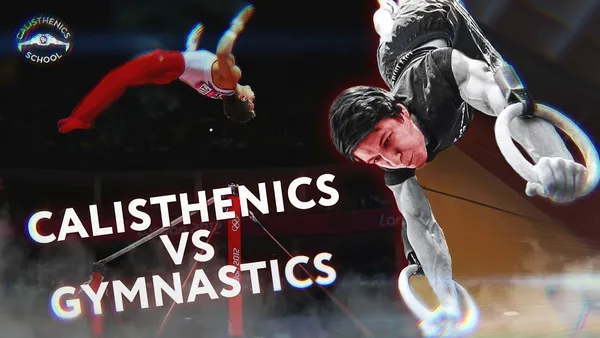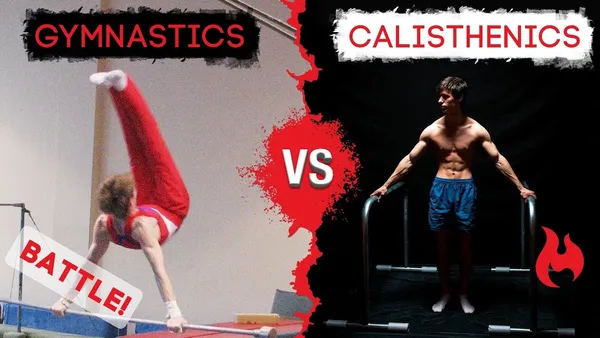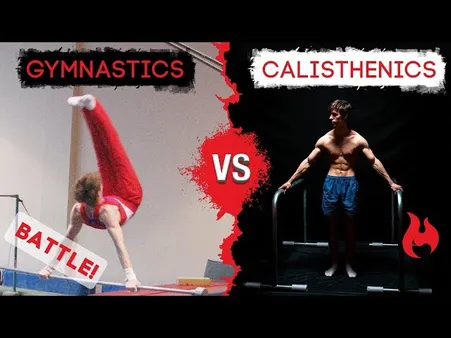Table of Contents
Welcome to Kizworld, your go-to source for all things fitness! Today, we're diving into the exciting world of gymnastics vs calisthenics. Whether you're a seasoned athlete or just starting your fitness journey, understanding the differences between these two disciplines can help you make informed decisions about your training. From equipment to skills to benefits, we've got you covered. So sit back, relax, and let's explore the fascinating world of gymnastics vs calisthenics!
Gymnastics vs Calisthenics: Which One Is Right for You?
Feature | Gymnastics | Calisthenics |
|---|---|---|
Equipment | Required | Not required |
Location | Gym | Anywhere |
Competition | Yes | No |
Accessibility | Less accessible | More accessible |
Benefits | Improved flexibility, strength, coordination, self-confidence | Increased muscle mass, cardiovascular health, flexibility, self-confidence |
I. Gymnastics vs Calisthenics: Comparing Skills, Benefits, and Target Muscles
Skills and Techniques
Gymnastics and calisthenics both involve a wide range of skills and techniques, but they differ in their focus and complexity. Gymnastics emphasizes highly specialized skills, such as tumbling, vaulting, and uneven bars, which require years of dedicated training and practice. Calisthenics, on the other hand, focuses on bodyweight exercises that can be performed anywhere, with an emphasis on compound movements that engage multiple muscle groups simultaneously.
Benefits for Fitness and Health
Both gymnastics and calisthenics offer numerous benefits for fitness and health. Gymnastics helps improve flexibility, strength, coordination, and self-confidence. Calisthenics, on the other hand, is known for increasing muscle mass, cardiovascular health, flexibility, and self-confidence.
Target Muscles
Gymnastics and calisthenics target different muscle groups. Gymnastics exercises primarily target the upper body, including the shoulders, arms, and back. Calisthenics exercises, on the other hand, target both the upper and lower body, including the legs, core, and back.
Feature | Gymnastics | Calisthenics |
|---|---|---|
Equipment | Required | Not required |
Location | Gym | Anywhere |
Competition | Yes | No |
Accessibility | Less accessible | More accessible |
Ultimately, the choice between gymnastics and calisthenics depends on your personal goals and physical abilities. If you are looking for a highly specialized sport that requires years of training and competition, gymnastics may be a good fit. If you are looking for a more accessible and versatile form of exercise that can be done anywhere, calisthenics may be a better option.
Here are some related posts that you may find helpful:
- How to Do a Muscle-Up
- The Best Calisthenics Gifts and Accessories
- The Best Calisthenics Quotes and Motivation
Gymnastics vs Calisthenics: Comparing Skills, Benefits, and Target Muscles

II. Delving into the Differences: Equipment, Focus, and Complexity
Equipment: A Tale of Two Disciplines
Gymnastics and calisthenics differ significantly in their equipment requirements. Gymnastics relies heavily on specialized apparatus such as bars, beams, rings, and vaults, which are typically found in a dedicated gym setting. These tools provide support and assistance for gymnasts to perform complex maneuvers and skills. In contrast, calisthenics embraces a minimalist approach, utilizing primarily bodyweight and gravity as resistance. Practitioners can engage in calisthenics anywhere, from parks to their living rooms, without the need for specialized equipment.
Focus: Artistic Expression vs Functional Fitness
The focus of gymnastics revolves around artistic expression and competitive performance. Gymnasts strive to execute graceful and intricate routines that showcase their strength, flexibility, and coordination. The emphasis is on aesthetics, precision, and the pursuit of perfection. Calisthenics, on the other hand, prioritizes functional fitness and overall body development. Practitioners aim to build strength, endurance, and mobility through a variety of bodyweight exercises. The focus is on improving physical capabilities and achieving a well-rounded fitness level.
Complexity: A Gradual Progression vs Rapid Advancement
Gymnastics is renowned for its high level of complexity and technical difficulty. Mastering gymnastic skills requires years of dedicated training and specialized coaching. The progression is gradual, with gymnasts advancing through a series of increasingly challenging levels. Calisthenics, while also demanding, offers a more accessible entry point. Beginners can start with fundamental exercises and gradually progress to more advanced variations as they gain strength and proficiency. The learning curve is typically faster, allowing individuals to see noticeable results in a shorter timeframe.
Feature | Gymnastics | Calisthenics |
|---|---|---|
Equipment | Required | Not required |
Location | Gym | Anywhere |
Competition | Yes | No |
Accessibility | Less accessible | More accessible |
- Related post: How to Do a Muscle Up
- Related post: The Best Calisthenics Gifts and Accessories
- Related post: The Best Calisthenics Quotes and Motivation
Delving into the Differences: Equipment, Focus, and Complexity

III. Choosing the Right Fit: Exploring Personal Goals and Physical Abilities
Consider Your Goals
When choosing between gymnastics and calisthenics, it's crucial to consider your personal goals. Gymnastics emphasizes competitive performance, while calisthenics focuses on overall fitness and bodyweight exercises. If you aspire to compete in gymnastics, you'll need access to specialized equipment and coaching. Calisthenics, on the other hand, offers more flexibility and can be practiced anywhere, making it suitable for those seeking general fitness improvements.Learn more about the history and evolution of gymnastics
Assess Your Physical Abilities
Your physical abilities also play a significant role in your choice. Gymnastics requires a high level of flexibility, strength, and coordination. If you're new to physical activity or have limited mobility, calisthenics may be a more accessible option. Calisthenics exercises can be modified to suit different fitness levels, allowing you to progress gradually.Discover the benefits and variations of calisthenics exercises
Gymnastics | Calisthenics |
|---|---|
Requires specialized equipment | Can be practiced anywhere |
Emphasizes competitive performance | Focuses on overall fitness |
Suitable for individuals with high flexibility, strength, and coordination | Accessible to individuals of varying fitness levels |
Choosing the Right Fit: Exploring Personal Goals and Physical Abilities

IV. Making the Switch: Transitioning from One Discipline to the Other
Easing into the Transition
Making the switch from gymnastics to calisthenics or vice versa requires a gradual approach. Start by incorporating elements of the new discipline into your existing routine. For instance, if you're a gymnast transitioning to calisthenics, begin by practicing bodyweight exercises like push-ups and squats. Conversely, if you're a calisthenics enthusiast venturing into gymnastics, try attending a beginner-friendly gymnastics class to learn basic skills like handstands and cartwheels.How to Do a Muscle Up
Adapting to Different Training Methods
Gymnastics and calisthenics employ distinct training methods. Gymnastics emphasizes structured routines and precise execution, while calisthenics focuses on freestyle movements and progressive overload. To adapt to these differences, gymnasts transitioning to calisthenics should embrace the freedom of movement and experimentation. Calisthenics practitioners switching to gymnastics, on the other hand, should prioritize technique and form to prevent injuries.The Best Calisthenics Gifts and Accessories
Leveraging Transferable Skills
Despite their differences, gymnastics and calisthenics share common ground in terms of physical attributes and skills. Both disciplines require strength, flexibility, and coordination. Gymnasts transitioning to calisthenics can leverage their existing strength and flexibility, while calisthenics practitioners switching to gymnastics can benefit from their coordination and body awareness.
Gymnastics | Calisthenics |
|---|---|
Structured routines | Freestyle movements |
Precise execution | Progressive overload |
Emphasis on technique | Emphasis on experimentation |
Overcoming Challenges
Transitioning between gymnastics and calisthenics presents unique challenges. Gymnasts may struggle with the lack of structure in calisthenics, while calisthenics practitioners may find the rigid routines of gymnastics restrictive. To overcome these challenges, it's crucial to approach the transition with an open mind and a willingness to learn. Seek guidance from experienced practitioners in both disciplines to facilitate a smooth and successful switch.The Best Calisthenics Quotes and Motivation
Embracing the Journey
The transition from gymnastics to calisthenics or vice versa is a journey of growth and discovery. Embrace the challenges and opportunities that come with it. By combining the best of both worlds, you can develop a well-rounded fitness regimen that aligns with your goals and aspirations.
Making the Switch: Transitioning from One Discipline to the Other

V. Conclusion
Gymnastics and calisthenics are both great ways to get fit, but they have different benefits and drawbacks. Gymnastics is more structured and competitive, while calisthenics is more flexible and accessible. Ultimately, the best choice for you depends on your individual goals and preferences. If you're looking for a structured and competitive activity that will help you develop strength, flexibility, and coordination, then gymnastics may be a good option for you. However, if you're looking for a more flexible and accessible activity that you can do at home or on the go, then calisthenics may be a better choice. No matter which activity you choose, make sure to start slowly and gradually increase the intensity and duration of your workouts over time. This will help you avoid injuries and get the most out of your workouts.